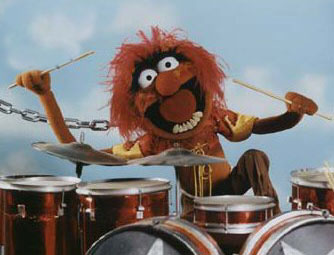
Moving Pictures is Rush’s finest album.
With the Beyond The Lighted Stage documentary fresh in our minds and a great (it really is – their best since Hold Your Fire to my ears) new album, Chocolate Orange Clockwork Angels just released, there has never been a better time to delve into Rush’s past. There’s certainly plenty of it.
For new Rush listeners however, a nineteen strong (studio) back catalogue might be a little indigestible. In the nicest possible way, listening to twenty hours of Rush is probably not on most people’s list of Things To Do For Fun Today.
Indeed, there are rumours (that I have started) that soldiers began to use it as an interrogation technique along with water-boarding, but that it was deemed too cruel.
So how to decide? Chronological order? Alphabetical order? iPod shuffle? Google? Ouija board?
You can’t really base your decision on something random such as what the album covers look like. They are, um, quirky. I’d hate to think what having a naked man on the cover of the excellent Hemispheres did for album sales in the late seventies for example. Not as big an effect as a naked picture of Gene Simmons would do on a Kiss record nowadays I suspect. Only for a band like One Direction are such tactics going to have a positive effect.
Apologies for putting that disturbing Gene Simmons image into your mind, by the way. Wrong of me. Thankfully, Rush similarly decided against Geddy Lee posing for their Hemispheres picture. That’d make even the kimono pictures look pleasant.
* For those who are interested, see the bottom of this post for a cut-out-and-keep guide to How To Buy Rush.
For the casual listener, Rush’s best album is 1980’s Moving Pictures. It deserves its place on my Beginner’s Guide to Hard Rock page.

Although the album cover is unpromising – people literally moving pictures into a museum (oh how we laughed at the clever pun. Not.), it is an extraordinary record – not least because of its extraordinary musicianship.
I have no idea what opening track Tom Sawyer‘s about. I’m not especially interested. I just love that opening synth-and-guitar power chord though. Listen to the track now on the Spotify link below, and check what you are doing with your hands about two and a half minutes in. If you’re not air-drumming, see a doctor: you may not have a pulse. Rush remain the only band where there are more “air drummers” than “air guitarists” thanks to Neil Peart‘s spectacular gifts.
He’s almost as good as Animal from The Muppets. Almost. Actually, scratch that. He’s better. Imagine Animal after six espressos and you’re starting to get near how good he is.
I watched a Rush live video many years ago: During Tom Sawyer the camera panned around to reveal the first three rows of the crowd all air drumming in unison. It’s not cool. In fact it’s as geeky as a Star Trek fan and a World of Warcraft fan fighting over a Dungeons and Dragons comic. But resistance is futile.
Limelight’s lyrics on the other hand are as great a shrugging of the shoulders of fame as ever articulated in a song.
YYZ is more limited on the lyric front, having the benefit for non-believers of being an instrumental, and thus free of those helium-filled tones of Geddy Lee (see previous post).
I saw Rush live on the Hold Your Fire and Roll The Bones tours at Wembley Arena. The lights! The back projections! They can actually play all those twiddly bits live! Amazing! It was the most impressive “wow – he can really play” moment since I saw Andrew Ridgley play the guitar solo in Wham’s Edge of Heaven video. (seriously – I just thought he was there to make George look manly: I nearly fell off my chair seeing him a) hold the guitar the right way up and b) actually appear to play the thing, no matter how bad it was…).
Detractors say that Rush is what you get if you let the drummer write the songs, but I wouldn’t have it any other way.
* Rush Buyers Guide:
So here’s my suggestion. Rush broadly followed a pattern for their first fifteen albums. Four studio records, each better than the last, followed by a live album. Then they would take a step back, but change direction a bit, produce four new albums, each one better than the last, then a live album, change of direction, four studio records, each better than the last, then a live album. That’s the most succinct Rush buyers guide you’ll ever find, and it takes you all the way up to Hold Your Fire….which will keep you busy enough for some time…
Record #57: Rush – Tom Sawyer


Leave a reply to every record tells a story Cancel reply